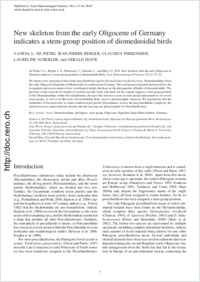New skeleton from the early Oligocene of Germany indicates a stem-group position of diomedeoidid birds
- De Pietri, Vanesa L. Naturhistorisches Museum der Buergergemeinde Bern, Switzerland
- Berger, Jean-Pierre Dept. Geosciences-Earth Sciences, University of Fribourg, Switzerland
- Pirkenseer, Claudius Dept. Geosciences-Earth Sciences, University of Fribourg, Switzerland
- Scherler, Laureline Dept. Geosciences-Earth Sciences, University of Fribourg, Switzerland
- Mayr, Gerald Forschungsinstitut Senckenberg, Sektion Ornithologie, Frankfurt am Main, Germany
-
20.11.2009
Published in:
- Acta Palaeontologica Polonica. - 2010, vol. 55, no. 1, p. 23-34
English
We report a new specimen of the extinct procellariiform species Diomedeoides brodkorbi (Aves, Diomedeoididae) from the early Oligocene (Rupelian) of Rheinweiler in southwestern Germany. The well−preserved partial skeleton allows the recognition and reassessment of new osteological details that bear on the phylogenetic affinities of diomedeoidids. The presence on the coracoid of a deeply excavated, cup−like facies articularis for the scapula suggests a stem group position of the Diomedeoididae within Procellariiformes, because this trait also occurs in stem−group representatives of several avian groups, as well as in Mesozoic non−neornithine birds, and is a plesiomorphic character. We hypothesize that the similarities of Diomedeoides to extant southern storm−petrels (Oceanitinae), such as the long mandibular symphysis, the small processus supracondylaris dorsalis and the long legs are plesiomorphic for Procellariiformes.
- Faculty
- Faculté des sciences et de médecine
- Department
- Département de Géosciences
- Language
-
- English
- Classification
- Palaeontology
- License
- License undefined
- Identifiers
-
- RERO DOC 17468
- DOI 10.4202/app.2009.0069
- Persistent URL
- https://folia.unifr.ch/unifr/documents/301548
Statistics
Document views: 176
File downloads:
- berg_nse.pdf: 126
